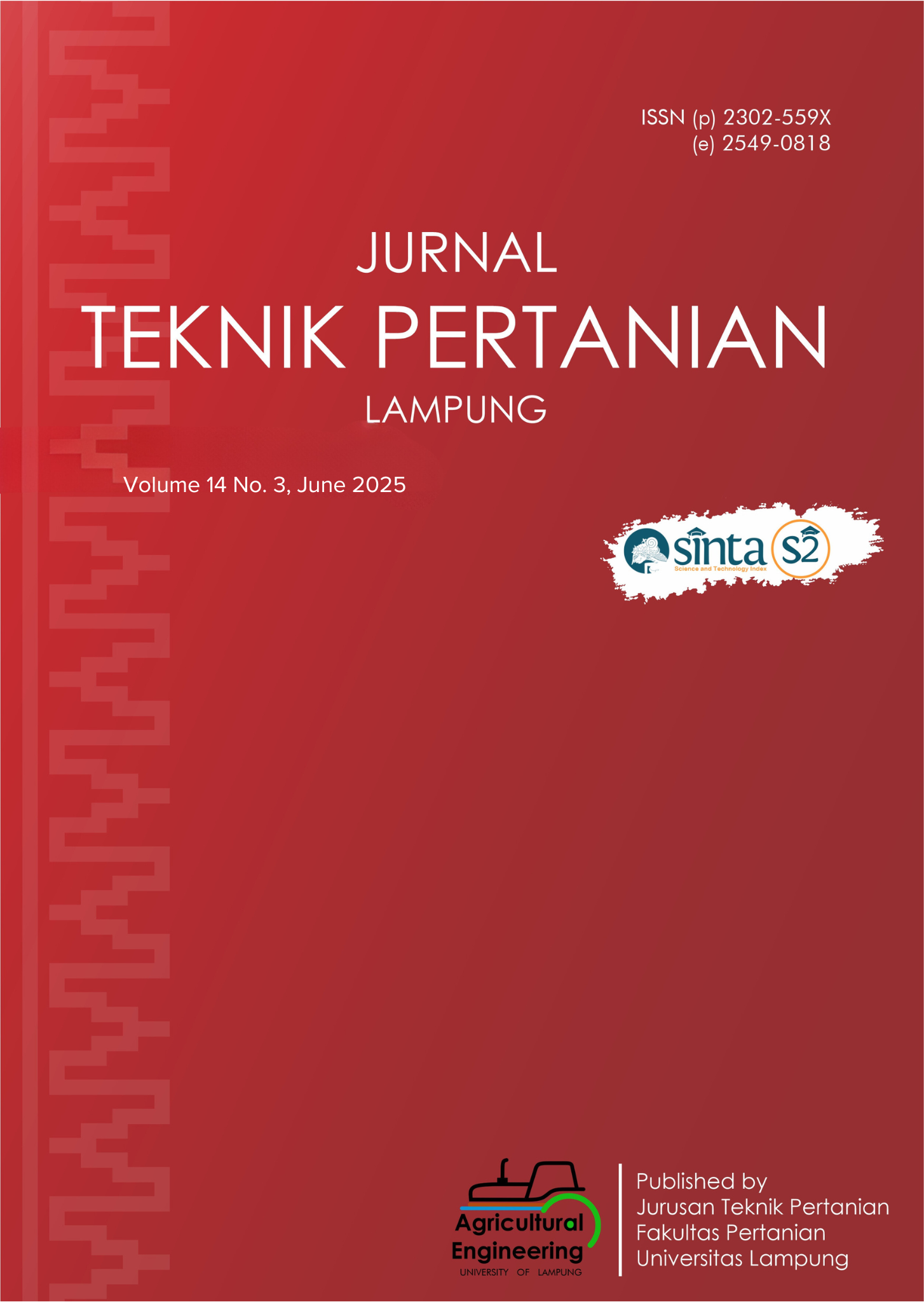Analysis of Load Testing on the Fresh Fruit Bunch Catching Component of the Electric Bunch Harvester (E-Bhar) Machine and its Impact on Fresh Fruit Bunch Quality
DOI:
https://doi.org/10.23960/jtep-l.v14i3.1073-1084 Abstract View: 132
Abstract View: 132
Abstract
This study aims to test the loading on the catcher components of the E-Bhar machine, as well as estimate the bruise index (BI) and free fatty acids (FFA) in the Fresh Fruit Bunches (FFB) caught. The loading test was conducted by dropping artificial FFB weighing 35 kg from a height of 1 m for 16 trials to analyze the deformation that occurred on the catcher components. Additionally, the BI was manually observed based on variations in the height of the FFB during harvesting. The results showed that an increase in the dropping height of the FFB caused an increase in potential force, which impacted the damage to the FFB. The potential force simulation results on the E-Bhar machine's catcher components ranged from 143.35 N to 2300.38 N, with BI values between 2.38 and 6.69. The maximum BI of 6.69 at a height of 10 m indicates damage approaching the critical value, thus threatening the quality of the FFB. The percentage of FFA ranged from 2.30% to 7.85%, exceeding the maximum limit of 5% set by the palm oil mill according to (SNI 01-2901-1992). These findings emphasize the advantage of using the catcher components in the E-Bhar machine to maintain good quality of the harvested FFB.
Keywords: Bruise index, Catcher component, Deformation, Free fatty acids, Load testing.
Downloads
References
Abangba, A.F., Adekunle, K.C., Ayirebi, A.A., & Ofori, Y.O. (2024). Performance evaluation, machine parameters and ergonomic aspects of palm fruit harvesters. Journal of Advanced Research in Applied Mechanics, 122(1), 14–31. https://doi.org/10.37934/aram.122.1.1431
Al-Jawadiab, R.A., Ahmad, D., Nawi, N.M., & Saufi, M. (2018). Mechanized harvesting of oil palm fresh fruit bunches: A review. Conference: Capacity Building in Agriculture, Forestry and PlantationAt: Hotel Bangi-Putrajaya, Bangi, Malaysia.
Basyuni, M., Amri, N., Putri, L.A.P., Syahputra, I., & Arifiyanto, D. (2017). Characteristics of fresh fruit bunch yield and the physicochemical qualities of palm oil during storage in North Sumatra, Indonesia. Indonesian Journal of Chemistry, 17(2), 182–190. https://doi.org/10.22146/ijc.24910
Bergman, R.N., & Ader, M. (2000). Free fatty acids and pathogenesis of type 2 diabetes mellitus. Trends in Endocrinology & Metabolism, 11(9), 351–356. https://doi.org/10.1016/S1043-2760(00)00323-4
Cherie, D., Herodian, S., Ahmad, U., Tineke, M., & Makky, M. (2015). Optical characteristics of oil palm fresh fruits bunch (FFB) under three spectrum regions influence for harvest decision. International Journal on Advanced Science, Engineering and Information Technology, 5(3), 255. http://dx.doi.org/10.18517/ijaseit.5.3.534
Cherie, D., Rini, R., & Makky, M. (2019). Determination of the optimum harvest window and quality attributes of oil palm fresh fruit bunch using non-destructive shortwave infrared spectroscopy. AIP Conference Proceedings, 2155, 020034. https://doi.org/10.1063/1.5125538
Ellingwood, B.R. (2003). Toward load and resistance factor design for fiber-reinforced polymer composite structures. Journal of Structural Engineering, 129(4), 449–458. https://doi.org/10.1061/(ASCE)0733-9445(2003)129:4(449)
Foster, B.P., Sitepu, B., Setiawati, U., Kelanaputra, E.S., Nur, F., Rusfiandi, H., Rahmah, S., Ciomas, J., Anwar, Y., Bahri, S., Caligari, P.D.S. (2017). Oil palm (Elaeis guineensis). Genetic Improvement of Tropical Crops, 241–290. https://doi.org/10.1007/978-3-319-59819-2_8
Goh, J.Y., Yunos, Y.M., & Ali, M.S.M. (2024). Fresh fruit bunch ripeness classification methods: A review. Food and Bioprocess Technology, 18, 1–24. https://doi.org/10.1007/s11947-024-03483-0
Hadi, S., Ahmad, D., & Akande, F.B. (2009). Determination of the bruise indexes of oil palm fruits. Journal of Food Engineering, 95(2), 322–326. https://doi.org/10.1016/j.jfoodeng.2009.05.010
Hamsi, A., Sitorus, T.B., & Isma, T.B. (2020). Design assembling and testing of the oil palm bunches cutting machines. IOP Conference Series: Materials Science and Engineering, 1003, 012016. https://doi.org/10.1088/1757-899X/1003/1/012016
Hearn, E.J. (1997). Mechanics of Materials 2: An Introduction to the Mechanics of Elastic and Plastic Deformation of Solids and Structural Materials. Elsevier Ltd. https://doi.org/10.1016/B978-0-7506-3266-9.X5000-8
Henson, I.E. (2012). 5 - Ripening, harvesting, and transport of oil palm bunches. Palm Oil, 137–162. https://doi.org/10.1016/B978-0-9818936-9-3.50008-3
Herodian, M., & Desrial, S (2023). Desain sasis dan e-powertrain mesin pemanen tandan buah segar kelapa sawit. [Undergraduate Thesis], IPB. http://repository.ipb.ac.id/handle/123456789/125607
Jovančić, P.D., Ignjatović, D., Tanasijević, M., & Maneski, T. (2011). Load-bearing steel structure diagnostics on bucket wheel excavator, for the purpose of failure prevention. Engineering Failure Analysis, 18(4), 1203–1211. https://doi.org/10.1016/j.engfailanal.2011.03.001
Kassim, M.S.M., Ismail, W.I.W., Ramli, A.R., & Bejo, S.K. (2014). Image clustering technique in oil palm fresh fruit bunch (FFB) growth modeling. Agriculture and Agricultural Science Procedia, 2, 337–344. https://doi.org/10.1016/j.aaspro.2014.11.047
Krisdiarto, A.W., Sutiarso, L., & Widodo, K.H. (2017). Optimasi kualitas tandan buah segar kelapa sawit dalam proses panen-angkut menggunakan model dinamis. Agritech, 37(1), 102–108. https://doi.org/10.22146/agritech.17015
Kumar, D., & Normala, S.G. (2021). Change management in oil palm plantations: Case research. Horizon Books (A Division of Ignited Minds Edutech P Ltd). https://horizonbooks.asia/buy-books/change-management-in-oil-palm-plantations-case-research/
Lai, J.W., Ramli, H.R., Ismail, L.I., & Hasan, W.Z.Z. (2023). Oil palm fresh fruit bunch ripeness detection methods: A systematic review. Agriculture, 13(1), 156. https://doi.org/10.3390/agriculture13010156
Makky, M., & Soni, P. (2013). Development of an automatic grading machine for oil palm fresh fruits bunches (FFBs) based on machine vision. Computers and Electronics in Agriculture, 93, 129–139. https://doi.org/10.1016/j.compag.2013.02.008
Mohamaddan, S., Rahman, M.A., Andrew_Munot, M., Tanjong, S.J., Deros, B.M., Dawal, S.Z.Md., & Case, K. (2021). Investigation of oil palm harvesting tools design and technique on work-related musculoskeletal disorders of the upper body. International Journal of Industrial Ergonomics, 86, 103226. https://doi.org/10.1016/j.ergon.2021.103226
Mu, T., Liu, L., Lan, X., Liu, Y., & Leng, J. (2018). Shape memory polymers for composites. Composites Science and Technology, 160, 169–198. https://doi.org/10.1016/j.compscitech.2018.03.018
Opara, U.L., & Pathare, P. B. (2014). Bruise damage measurement and analysis of fresh horticultural produce-A review. Postharvest Biology and Technology, 91, 9–24. https://doi.org/10.1016/j.postharvbio.2013.12.009
Pakdeechot, S., Hanifarianty, S., & Wae-hayee, M. (2020). The effects of sterilization time of FFB on fruit-bunch separation and crude palm oil quality using direct steaming. Journal of Advanced Research in Applied Mechanics, 72(1), 1–9. https://doi.org/10.37934/aram.72.1.19
Ruswanto, A., Ramelan, A., Praseptiangga, D., & Ida, B. (2020). Effects of ripening level and processing delay on the characteristics of oil palm fruit bunches. International Journal on Advanced Science Engineering and Information Technology, 10(1), 389-394. https://doi.org/10.18517/ijaseit.10.1.10987
Sales, A., Siviero, M.A., Pereira, P.C.G., Vieira, S.B., Berberian, G.A., & Miranda, B.M. (2020). Estimation of the commercial height of trees with laser meter: a viable alternative for forest management in the Brazilian Amazon. Ecology and Evolution, 10(8), 3578–3583. https://doi.org/10.1002/ece3.4102
Schwab, R., & Ruff, V. (2013). On the nature of the yield point phenomenon. Acta Materialia, 61(5), 1798–1808. https://doi.org/10.1016/j.actamat.2012.12.003
Sharif, Z.B.M., Taib, N.B.M., Yusof, M.S.B, Rahim, M.Z.B, Tobi, A.L.B.M., & Othman, M.S.B. (2017). Study on handing process and quality degradation of oil palm fresh fruit bunches (FFB). IOP Conference Series: Materials Science and Engineering, 203, 012027. https://doi.org/10.1088/1757-899X/203/1/012027
Sutton, M.A., Orteu, J-J., & Schreier, H.W. (2009). Image Correlation for Shape, Motion and Deformation Measurements: Basic Concepts, Theory and Applications. Springer Science & Business Media.
Thang, Y.M., Yunus, R., Mokhtar, M.N., Appleton, D.R., Asis, A.J., Kong, P.S., Teh, H.F., & Ariffin, A.A. (2021). Roles and Principles of Sterilisation Process in Palm Oil Mills. Pertanika Journal of Science & Technology, 29(4). https://doi.org/10.47836/pjst.29.4.26
Tumova, J., Andel, M., & Trnka, J. (2016). Excess of free fatty acids as a cause of metabolic dysfunction in skeletal muscle. Physiological Research, 65(2), 193-207. https://doi.org/10.33549/physiolres.932993
Ugural, A.C. (2016). Mechanical Design of Machine Components: SI Version. Taylor & Francis Group.
Wang, W.H. (2012). The elastic properties, elastic models and elastic perspectives of metallic glasses. Progress in Materials Science, 57(3), 487–656. https://doi.org/10.1016/j.pmatsci.2011.07.001
Williams, E. (1956). Hooke’s Law and the Concept of the Elastic Limit. Annals of Science, 12(1), 74–83. https://doi.org/10.1080/00033795600200056
Wulandari, N., Muchtadi, T.R., Budijanto, S., & Sugiyono. (2011). Physical Properties of Crude Palm Oil and Their Correlations to the Quality Attributes. Jurnal Teknologi Dan Industri Pangan, 22(2), 177-183.
Zolfagharnassab, S., Shariff, A.R.B.M., Ehsani, R., Jaafar, H.Z., & Aris, I.B. (2022). Classification of oil palm fresh fruit bunches based on their maturity using thermal imaging technique. Agriculture, 12(11), 1779. https://doi.org/10.3390/agriculture12111779
Downloads
Published
How to Cite
Issue
Section
License
Authors who publish with this journal agree to the following terms:
Authors retain copyright and grant the journal right of first publication with the work simultaneously licensed under a Creative Commons Attribution-ShareAlike 4.0 International Lice that allows others to share the work with an acknowledgement of the work's authorship and initial publication in this journal.
Authors are able to enter into separate, additional contractual arrangements for the non-exclusive distribution of the journal's published version of the work (e.g., post it to an institutional repository or publish it in a book), with an acknowledgement of its initial publication in this journal.
Authors are permitted and encouraged to post their work online (e.g., in institutional repositories or on their website) prior to and during the submission process, as it can lead to productive exchanges, as well as earlier and greater citation of published work (See The Effect of Open Access).
Jurnal Teknik Pertanian Lampung

JTEPL is licensed under a Creative Commons Attribution-ShareAlike 4.0 International License.













